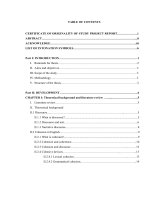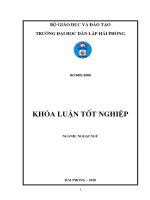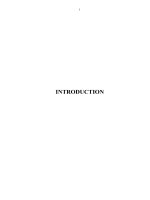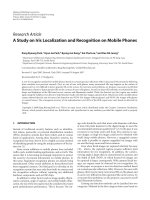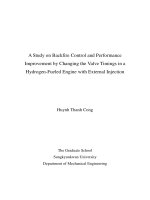A study on school dropouts and student strength of Dharwad District of Karnataka, India
Bạn đang xem bản rút gọn của tài liệu. Xem và tải ngay bản đầy đủ của tài liệu tại đây (435.85 KB, 10 trang )
Int.J.Curr.Microbiol.App.Sci (2019) 8(2): 1887-1896
International Journal of Current Microbiology and Applied Sciences
ISSN: 2319-7706 Volume 8 Number 02 (2019)
Journal homepage:
Original Research Article
/>
A Study on School Dropouts and Student Strength of
Dharwad District of Karnataka, India
S.V. Halawar*
Karnatak Arts College Dharwad, India
*Corresponding author:
ABSTRACT
Keywords
Education, School
dropouts, ANOVA,
t-test
Article Info
Accepted:
15 January 2019
Available Online:
10 February 2019
Keeping in view, the increasing importance of education in India, this study is an attempt
to understand the nature of student strength and school dropouts. To realize these
objectives it is collected the secondary data from district BEO office, Public Education
sector (Sarvajanika Shikshana Elake), Dharwad. Results are derived by using statistical
techniques such as bar diagrams, linear trend analysis, t-test and analysis of variance. The
results reveals that female student strength is comparatively high in the government
schools from 2011-12 to 16-17 and male strength in private schools and later during 201718, this scenario has changed and also observed the significant difference in the school
dropouts year wise.
Introduction
Education is the passport to accelerate
economic growth. It is the key to build a
nation. In India, under various constitutional
provisions and five year plans educational
facilities have been expanded at all levels.
According to article 45 of the constitution of
India, the state shall endeavor to provide
within a period of ten years from the
commencement of this constitution for free
and compulsory education for all children
until they complete the age of fourteen years.
As per 93rd amendment to the constitution,
now elementary education has become the
fundamental right of every child, but still
millions of children are out of school. The top
most reasons for dropping out are lack of
interest in studies, economic conditions of the
parents, migration of the family and to help
the family in domestic work.
After dropping out, the children are involved
in helping their parents in household work,
field work, working to earn money, most of
students are also sitting idle and doing
nothing more or less the students after
dropping out from upper primary classes are
helping the parents in earning the money,
either by getting them involved in the
agriculture and allied activities or directly by
doing work to earn money (Rao et al., 2004;
1887
Int.J.Curr.Microbiol.App.Sci (2019) 8(2): 1887-1896
Rao and Mohan, 2000; Chatterjee, 1975;
Chatterjee and Madhusudan, 1998; Chitnis
Suma, 1982).
In addition to the short-term nature of many
studies of predictive variables (Ekstrom et al.,
1986), much of the recent dropout research
has been done with students from large
metropolitan areas (Fine, 1986) or has
focused on specific ethnic groups (Strong and
Robins, 1972; Fernandez and Shu, 1988).
Whether the results of these kinds of studies
are applicable to students in less urban areas
or to schools with a minimum percentage of
minority students has not been established.
Dropout in Secondary Education: A Study of
Children living in slums of Delhi (Sunita
Chugh, 2011), the dropout problem is
pervasive in the Indian education system.
Many children, who enter school, are unable
to complete secondary education and multiple
factors are responsible for children dropping
out of school. Risk factors begin to add up
even before students enroll in school that
includes: poverty, uneducated or low
educational level of parents, the weak family
support, pattern of schooling of sibling, and
lack of pre-school experiences. Family
background and domestic problems create an
environment which negatively affects the
value of education. Further, students could
drop out as a result of a multitude of school
factors such as unfriendly atmosphere, poor
comprehension, absenteeism, attitude and
behavior of the teachers and failure or
repetition in the same class, etc. When student
experience school failure, they become
disturbed with lack of achievement and end
up alienated and experience exclusion leading
to eventual dropout. It is essential to carefully
design preventive measures and intervention
strategies that could be adopted in order to
help all adolescent dropouts. Certain
precautionary measures can be implemented
throughout the target population, while others
must take into account the variety of dropout
profiles.
School Dropout across Indian States and
Union Territories, An Econometric Study
Rupon Basumatary Amguri College and
Research Scholar, Gauhati University,
Guwahati, Assam, INDIA stated that the
Central Government is implementing several
schemes in collaboration with State
Governments to ensure development in the
education sector. The Sarva Shiksha Abhiyan
is being implemented in accordance with the
norms and standards of the RTE Act to
enhance enrolment and retention of children,
with context- specific interventions for SC/
ST students and a multi–pronged approach for
reducing dropout rates. This includes interalia strengthening of school infrastructure and
facilities, residential hostel buildings for
children in habitations not covered by regular
schools, provisioning for additional teachers,
regular training of teachers, provision for free
text books and uniforms to children. The
Kasturba Gandhi Balika Vidyalaya Scheme
provides for setting up of residential upper
primary schools for girls from SCs, STs,
OBCs and Minority communities. The Mid
Day Meal Scheme is also being implemented
with a view to enhance enrolment and
retention of children in schools. Unlike many
other countries of the world today, India is
increasingly growing young as reflected in the
population profile of the country. According
to Census Bureau of India, 40% of population
is below the age of 18 and by 2015 it is
expected that 55% will be under the age of
20. With a satisfactorily large proportion of
population in the very young age, it is
expected that in 2020, the average Indian will
be only 29 years old, compared with the
average age of 37 years in China and the US,
45 in west Europe and 48 in Japan. This
demographic process will create a large and
growing labour force, which is expected to
deliver spin-offs in terms of growth and
1888
Int.J.Curr.Microbiol.App.Sci (2019) 8(2): 1887-1896
prosperity through a number of routes. People
of this young age group are measured to be
the most productive class of human resources.
Therefore, sustainability of economic
development of the country will depend on
how this section of people is built up and
utilized.
Materials and Methods
Here it is taken the secondary data from
district BEO office, Public Education sector
(Sarvajanika Shikshana Elake). It includes the
students’ strength and dropouts of students in
dharwad rural areas. We utilized the
necessary data for our study. And here it is
used statistical tools like trend analysis and
Analysis of variance to derive results of the
data.
Results and Discussion
Data analysis
From the Table 3 and Figure 3 Primary level
strength it is observed that overall strength
from 2010-11 to 2017-18 gradually
increasing, by observing the trend lines of
total primary level population, Govt. aided
and Private unaided schools strength of
students it is clear that how population is
increasing student strength is also increasing.
From the data it is observed that Government
aided schools strength is twice the strength of
private schools. In the government as well as
private schools till 2015-16 students strength
is almost constant but after that there is
significant increment in the strength, it may
be because of new rules in education system
or techniques like Nali Kali/ Kali Nali and
scholar ships like Vidyashree and so on (Fig.
2).
From Table 4 and figure 4 of Upper primary
level strength it is clearly observed that,
strength from 2010-11 to 2017-18 it is
gradually decreasing, by observing the
decreasing strength of the students we come
to know that overall strength of younger
population is decreasing. From the figure 4 it
is observed that government school students’
strength is trice the strength of private schools
in upper primary level. From 2010-11 to
2015-16 student strength is almost constant
after that there is sudden decrement in the
strength.
Gender wise primary level strength in the
Government and Private Schools
From table 5 and figure 5 Primary level
gender wise strength in the Govt. schools, it is
observed that except the year 2017-18 from
2010-11 to 2016-17 female strength is slightly
more than male strength and another view of
the graph shows that there is not much
difference in the sex ratio of dharwad district.
From the paired t-test is found non-significant
at 5% level of significance, that show there is
a no difference in strength of male and female
in the government schools. If we compare
figure 5 and 6 it is understood that parents
view in case of giving education to their
children is varying gender wise, we can
clearly observe that in the Government
schools female population is high where as in
the private schools male population is high.
From Table 6 and figure 6 Primary level
gender wise strength in the Private schools, it
is observed that from 2010-11 to 2017-18
male strength is slightly more than female
strength. From the paired t-test is found
significant at 5% level of significance, that
show there is a significant difference in
strength of male and female in the private
schools. This analysis shows that parents are
interested to join their male child to private
schools for their good opinion about private
school. From the figure it is observed that
from 2010-11 to till 2015-16 male as well as
female student’s strength in the private
1889
Int.J.Curr.Microbiol.App.Sci (2019) 8(2): 1887-1896
schools is slowly increasing, but for the year
16-17 and 17-18 it is decreased and from the
figure-3 govt. school strength is increasing
suddenly. By observing this, we come to
know that govt. Education department
drawing new techniques to attract students
towards govt. schools and improving the
education quality.
Table.1 Year wise data analysis of different areas of dharwad district
Districts
2012-13 2013-14 2014-15 2015-16 2016-17 2017-18 2018-19
91
25
516
18
14
6
13
Dharwad
rural
265
54
583
10
12
3
5
Dharwad
city
141
37
660
35
22
19
5
Hubli
rural
103
306
86
27
26
8
Hubli city 496
81
355
9
32
7
8
Kalgatagi 236
59
307
50
10
1
6
Kundagol 168
55
430
20
4
15
12
Navalgund 123
H0: There is no significant difference in the year wise number of drop outs (OOSC).
H1: There is a significant difference in the year wise number of drop outs (OOSC).
Between Groups
Within Groups
Total
ANOVA
OOSC (Out of School Children)
Sum of Squares
Df
Mean Square
1155107.347
6
192517.891
240017.714
42
5714.707
1395125.061
48
F
33.688
Table.2 Post Hoc Tests
Homogeneous Subsets
Tukey HSD
Factor
N
Subset for alpha = 0.05
1
2
3
2018-19 7
8.1429
2017-18 7
11.0000
2016-17 7
17.2857
2015-16 7
32.5714
2013-14 7
59.1429
2012-13 7
217.1429
2014-15 7
451.0000
Sig.
.865
1.000
1.000
Means for groups in homogeneous subsets are displayed.
a. Uses Harmonic Mean Sample Size = 7.000.
1890
Sig.
.000
Int.J.Curr.Microbiol.App.Sci (2019) 8(2): 1887-1896
Fig.1 Means plots
Table.3 Family Level Strength
Year
Gov+Aided Pvt+Unaided
Total
2010-11
124661
52719
178716
2011-12
111286
58796
171584
2012-13
105043
53428
159960
2013-14
98473
53249
153165
2014-15
102387
61221
163608
2015-16
103293
62460
167164
2016-17
163562
74610
238172
2017-18
209949
98082
308031
1891
Int.J.Curr.Microbiol.App.Sci (2019) 8(2): 1887-1896
Fig.2
Fig.3
1892
Int.J.Curr.Microbiol.App.Sci (2019) 8(2): 1887-1896
Table.4 Upper primary level strength
Year
Gov+Aided
Pvt+Unaided
Total
2010-11
2011-12
2012-13
78746
75,853
70957
22549
24909
23878
102368
101865
95940
2013-14
2014-15
2015-16
2016-17
2017-18
68199
68175
65528
40242
38768
23249
27213
28016
16782
17340
92511
95388
94159
57024
56108
Fig.4a
Fig.4b
1893
Int.J.Curr.Microbiol.App.Sci (2019) 8(2): 1887-1896
Table.5 Gender wise primary level strength in the Government and Private Schools
Government School Strength
Boys
Girls
Year
28946
28032
2010-11
28405
29742
2011-12
32934
34048
2012-13
38547
39621
2013-14
37155
37898
2014-15
38999
39747
2015-16
78090
85472
2016-17
125939 84010
2017-18
Fig.5
Paired Samples Test
Paired Differences
Mean Std.
Deviation
Pai
r
Boys
Girls
-
3805.
625
15596.71
1
Std. Error
Mean
5514.270
95%
Confidence
Interval
of
the
Difference
Lower
Upper
16844.80
9233.551
1
1894
t
df
Sig. (2tailed)
.690
7
.512
Int.J.Curr.Microbiol.App.Sci (2019) 8(2): 1887-1896
Table.6
Private Schools Strength
Boys
Girls
Year
38001
34805
2010-11
39161
37226
2011-12
42347
40787
2012-13
50540
48924
2013-14
50208
47453
2014-15
52360
50008
2015-16
44177
30433
2016-17
57478
40604
2017-18
Fig.6
Mean
Pair 1
Boys Girls
5504.
000
Paired Samples Test
Paired Differences
Std.
Std.
95% Confidence Interval
Deviation
Error
of the Difference
Mean
Lower
Upper
6134.247
2168.784
375.641
10632.359
One way analysis of variance test for difference
of several means is found to be significant at
5% level of significance, therefore Null
hypothesis (H0) is rejected. To observe a
specific factor/factors which are significantly
varied, it is tested the post hoc test (Tukeys),
from the test it is found the three homogeneous
subsets of non-significant factors. First subset
t
df
Sig. (2tailed)
2.538
7
.039
contains the factors 2013-14, 2015-16, 2016-17,
2017-18 and 2018-19 with P- value 0.865 and
second and third subsets contains only single
factor 2012-13 and 2014-15 which indicates,
these factors means are significantly varying
from all the factors with the P value 1.000.
These factors are non-significant within the
subset and significant between the subsets.
1895
Int.J.Curr.Microbiol.App.Sci (2019) 8(2): 1887-1896
From the means plot it is observed that for
2012-13 and 2014-15 No. of school dropouts is
high in the Dharwad district and later on it is
significantly decreased to zero. This analysis
reveals that there is a significant difference in
the year wise number of out of school children
(OOSC) and average school dropping students
is in control. And also observed the significant
difference in the year wise number of school
dropouts and average school dropouts are in
control.
In conclusion, it is clear from the study that the
primary level gender wise student strength in
the private schools, from 2010-11 to 2017-18
male strength is slightly more than female
strength and female strength in government
school is high. This analysis shows that parents
are interested to give education to their male
child from private schools because of their good
opinion about private school. From the figure it
is observed that from 2010-11 to till 2016-17
male as well as female student’s strength in the
private schools is slowly increasing, but for the
year 16-17 and 17-18 it is decreased and from
the figure-3 it is observed that male strength is
increased in the government school. By
observing this, we come to know that govt.
Education department drawing new techniques
to attract students towards government schools
and improving the education quality. From
analysis of variance to test equality of means of
different years school dropouts, we found
significant result that there is a variation in the
average dropout from year to year. And average
school dropouts are in control (near to zero by
2018).
References
Aggarwal Y.P. & Chugh Sunita (2003):
Learning Achievement of Slum
Children in Delhi, NIEPA Occasional
Paper 34, NIEPA.
Chatterjee, B. (1975): School Dropout among
Harijan Children: Causes and Cure
Central Institute of Research and
Training in Public Cooperation, New
Delhi, 1975. September 1998.
Chatterjee, B. (1975): School Dropout among
Harijan Children: Causes and Cure
Central Institute of Research and
Training in Public Cooperation, New
Delhi, 1975.
Chatterjee, Madhusudan (1998): The Primary
Education among the Poor in the City of
Calcutta Paper presented at NUEPA at
the workshop on “Indian Mega Cities
and Primary Education of the Poor",
September 1998.
Chitnis Suma (1982): Dropouts and low pupil
achievement among the urban poor in
Bombay, Tata Institute of Social
Science, Bombay, Mimeo.
Ekstrom. R. B.. Goert z. M. E.• Pollack. J. M..
& Rock. D. A. (1986). Who drops out of
high school and why?. Findings from a
national study. Teachers College
Record. 87. 356- 373.
Fine. M. (1986). Why urban adolescents drop
into and out of public high school.
Teachers College Record. 87. 393- 409.
Rao, Mohan, M.J. (2000). “Migration of labour
and school dropouts”, Social Welfare,
47(6): 26-31
Rao, Rama G and. Mohanty S.K, (2004),
“School Enrolment and Dropout:
Policies and Achievements”, Paper
presented in seminar on follow-up of the
National Population Policy- 2000:
Focus on EAG states, 25-27 Oct. 2004.
Stroup, A. L., & Robbins, L. N. (1972).
Elementary school predictors of high
school dropouts among black males.
Sociology oj Education, 45, 212-222.
How to cite this article:
Halawar, S.V. 2019. A Study on School Dropouts and Student Strength of Dharwad District of
Karnataka, India. Int.J.Curr.Microbiol.App.Sci. 8(02): 1887-1896.
doi: />
1896
